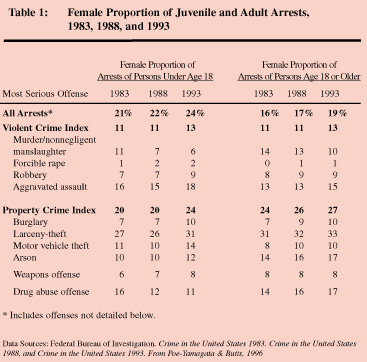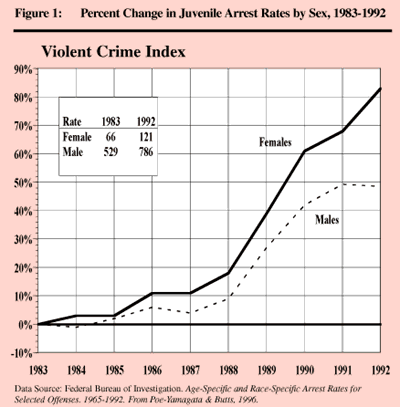What Is The Magnitude Of The Problem?
When gunshots ring out on a schoolyard or young gangsters terrorize a neighborhood with drive-by shootings, the young perpetrators are probably male. Boys in trouble tend to lash out. They set fires. They get into fights. They carry guns. They look dangerous. They inspire fear. They get attention.
Girls get into trouble more quietly. In most cases, they were victims themselves before they became offenders (Prescott, 1997; Girls Inc., 1996; Davis, Schoen, Greenburg, Desroches, & Abrams, 1997). When girls are angry, frightened, or unloved, they are more likely to strike inward. They may hurt themselves by abusing drugs, prostituting their bodies, starving, or even mutilating themselves (Belknap, 1996). Because girls in crisis are more likely to threaten their own well-being, they may not seem dangerous to society. As a result, their needs have been overlooked and undertreated (Chesney-Lind, 1988). Girls in trouble have been the afterthought of a juvenile justice system designed to deal with boys (Bergsmann, 1989; Miller, Trapani, Fejes-Mendoza, Eggleston, Dwiggins, 1995).
Overall, girls do pose a smaller problem than male delinquents. They commit far fewer crimes than boys. In 1995, girls accounted for about one-fourth of juvenile arrests (25.5 percent of those under 18 arrested in 1995 were female, according to the 1996 Sourcebook) (Maguire & Pastore, 1997). Girls who break the law may not be perceived as a danger to society because, traditionally, they have come into contact with the courts for nonviolent status offenses such as curfew violations, running away, or unruly behavior (Chesney-Lind, 1988). Theft cases account for nearly one-fourth of girls' arrests (Bergsmann, 1994). In 1995, 23.5 percent of arrests of girls under 18 were for larceny-thefts, according to the FBI Uniform Crime Report. During the same year, 32.5 percent of all juvenile theft arrests involved girls.
These trends appear to be changing. During the decade from 1983 to 1993, arrests of female juveniles increased by 31 percent (compared to 21 percent for boys). (See Table 1) Between 1989 and 1993, the relative growth in juvenile arrests involving females was 23 percent, more than double the 11 percent growth for males (Poe-Yamagata & Butts, 1996).

During the last decade, violent crime among girls has increased faster (16.5 percent) than for boys (4.5 percent) (Bergsmann, 1994). Females were responsible for 17 percent of the growth in juvenile arrests for Violent Crime Index offenses between 1989 and 1993 (Poe-Yamagata & Butts, 1996). (See Figure 1) During the same years, juvenile arrests for Violent Crime Index offenses increased by 55 percent for females compared to 33 percent for males (Poe-Yamagata & Butts, 1996). (See Figure 1) While status offenses continue to account for the bulk of cases involving girls, females are now more likely to be arrested for robbery, assault, drug trafficking, and gang activity—juvenile crimes only recently considered the exclusive domain of young males (Poe-Yamagata & Butts, 1996; Calhoun, Jurgens & Chen, 1993). Just between 1994 and 1995, girls' arrests increased 3 percent for aggravated assault (vs. a decline of 4.5 percent for boys); increased 7.7 percent for other assaults (vs. 1.8 percent increase for boys); increased 26.6 percent for drug abuse violations (vs. 16.7 percent for boys), according to Uniform Crime Reports.

Nationwide, girls are becoming involved with the justice system at a younger age. From 1987 to 1991, the number of 13- and 14-year-old girls in juvenile court increased by 10 percent (Bergsmann, 1994). One in five girls in secure confinement is now aged 14 or younger.
Ethnic minorities are disproportionately represented in the female offender population (Bergsmann, 1989; Campbell, 1995; Community Research Associates, 1997). African American girls comprise nearly half of all those in secure detention and Hispanics 13 percent (Bergsmann, 1994). Although 65 percent of the population is Caucasian, only 34 percent of girls in detention are Caucasian. Seven of every 10 cases involving white girls are dismissed, compared to three of every 10 cases dismissed for black girls.
Although their offenses are typically less violent, girls who break the law are sometimes treated more harshly than boys who offend (Davidson, 1982). There are fewer community-based services for girls. As a result, girls are twice as likely to be detained, with detention lasting five times longer for girls than boys (Girls Incorporated, 1996). In addition, girls are detained for less serious offenses. In 1987, 9 percent of girls in training schools were committed for status offenses, compared to 1.5 percent of boys.
| Guiding Principles for Promising Female Programming |
|